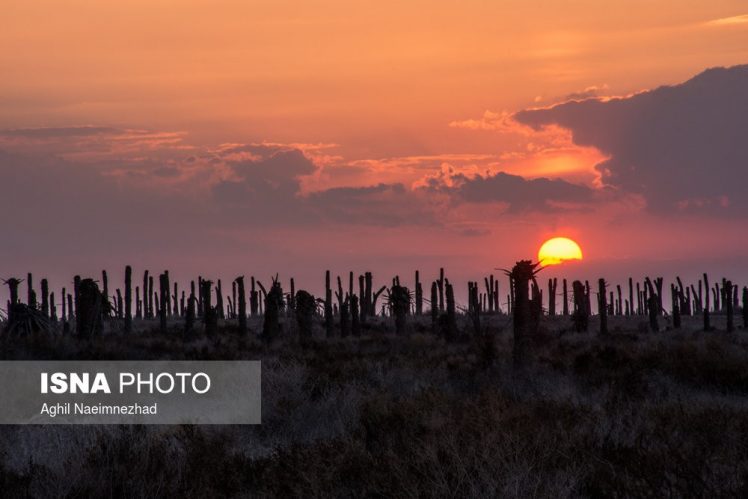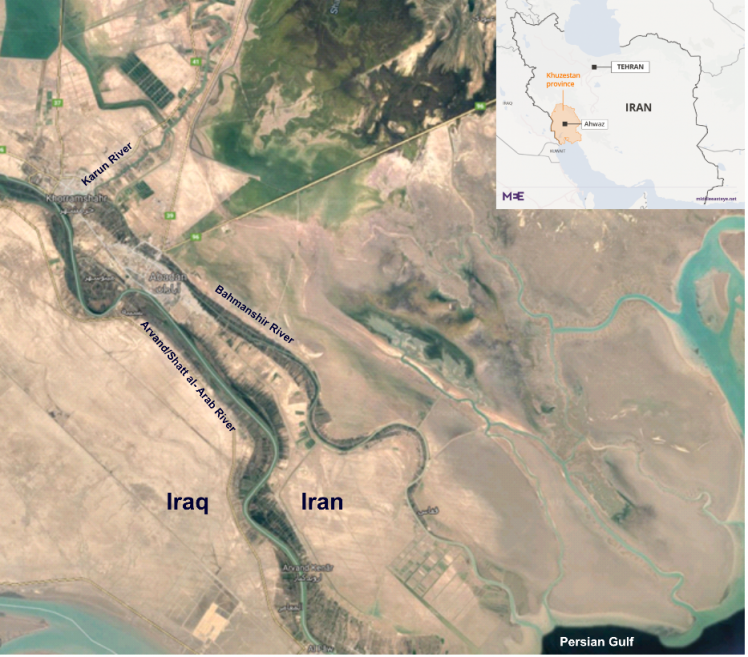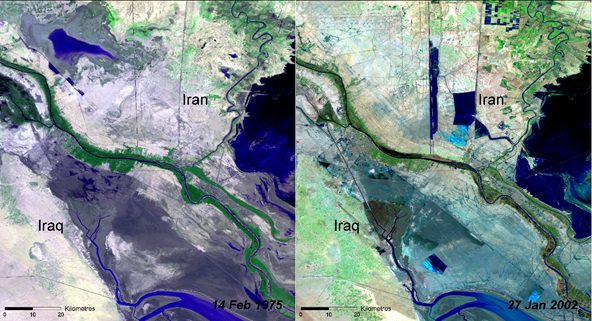“Once upon a night, spread fire to the reeds with whole flames,
Burned it to the end, as heart melts by falling tears.
Burned and burned, carelessly, the flame;
to, each reed has been burned as a mourning-candle on his grave.”
– Rumi (1207-1273), a famous Persian poet and Sufi mystic

This is the story of a palm cemetery that was historically a rich palm-grove in south-west of Iran, Khuzestan province. I would promise that this is not a curse from a mad God nor the painful legacy left from the mass destruction of Iran-Iraq’s war (1980-1988). All is about thirst, a juice of cursed salt in a river.

Having a long history back to Elam civilization (3000 BC), Khuzestan province is known as the heart of Iran not just by having rich oil and gas reserves but also by the five major rivers flowing through its plateau.

Two of these five major rivers, Karun and Karkheh, has the largest basins in Iran generated from Zagros Mountains. The Karun basin extended over a mountainous and foothill zones to inland/coastal-desert. The climate at the downstream region is extremely hot (air temperatures above 50°C) and the total annual precipitation is about 150 mm (UN-ESCWA, 2013). The Karun and Karkheh Rivers discharge into the Shatt al-Arab (a.k.a as Arvand-Rud in Persian) made by confluence of the Tigris and Euphrates rivers. Shatt al-Arab is a transboundary river between Iran and Iraq that forms the main source of freshwater to the Persian Gulf.

The Shatt al-Arab River is about 192 km from its origin to its mouth in the Persian Gulf; its basin in both neighboring countries was enriched by 17-18 million date palms (a fifth of the world’s 90 million palm trees) in the mid-1970s (UNEP, 2019).
According to UNEP (2019), by 2002, more than 14 million (80%) of the date palms were wiped out and the prime cause of this disaster that began emerging in the late 1960s is the salinity of the fresh water in the rivers.
Salinization is the result of a combination of natural and anthropogenic causes. Anthropogenic activities such as large-scale development of upstream water regulation and dam structures, together with the drainage of the Mesopotamian Marshes, agricultural, industrial and domestic effluents cause the salinization problem. However, the effect of the prolonged and intense crossfire of the Iran-Iraq war on the palm-grove should not be neglected. (Rahi Amtair, K., 2018).
The deposit salts in the ground are transported by groundwater to rivers and streams; moreover, the salt concentration in rivers increases by evaporation. These are salinization´s natural causes (Rahi Amtair, K., 2018). Furthermore, the effect of high tides that push saltwater from sea (in this case from Persian Gulf) to upstream is of a high importance among the natural effects.

For the irrigating of palm-groves and the farmlands on the bank of the rivers, many streams and water-intake facilities have been used for decades. The amounts of fresh water inflow from the rivers and the tide wave advance in the water way are inversely related together. Nowadays, by having low discharges of freshwater in the mentioned rivers, the tide wave more easily push saltwater upstream toward the farmland and the cities. For the last four decades, the salinity of the mentioned rivers has increased steadily. High salinity of the water made it unsuitable or even harmful for most domestic and agricultural uses (Rahi Amtair, K., 2018). Today, the present palm-groves comprising a treasure of more than 800 date varieties in both Iran and Iraq are facing a complete wipe-out (UNEP, 2010).
Going back a few centuries, date palms are known as very strong trees to be able to regenerate even from fire damages as Phoenix, the mythical bird sprang from the ashes (UNEP, 2010). This harmony with date palms’ botanical name, Phoenix dactylifera L. sounds astonishing. However, through decades, the “Heart of palm” (jamiegeller.com/browse/what-are-hearts-of-palm) have been slowed down due to the thirst and droughts; and I wish I knew if this Phoenix could be born again from the ashes!
/Roya Meydani, Doctoral student at KTH, November 2019
References
https://en.isna.ir/, accessed on November 2019.
https://www.google.se/maps, accessed on November 2019.
https://www.middleeasteye.net/opinion/iranian-government-killing-ahwazs-environment, accessed on November 2019.
Rahi Amtair.K, 2018, Salinity Management in the Shatt Al-Arab River, International Journal of Engineering & Technology, 7 (4.20) (2018) 128-133 (19) (PDF) Salinity Management in the Shatt Al-Arab River. Available from: https://www.researchgate.net/publication/330565088_Salinity_Management_in_the_Shatt_Al-Arab_River [accessed Nov 06 2019].
UN-ESCWA and BGR (United Nations Economic and Social Commission for Western Asia; Bundesanstalt für Geowissenschaften und Rohstoffe). 2013. Inventory of Shared Water Resources in Western Asia. Beirut.
UNEP, n.d., accessed 2019, Shatt al-Arab. Environmental Change Hotspots. Division of Early Warning and Assessment (DEWA). United Nations Environment Programme (UNEP).
UNEP, 2010. UNEP Atlas of Our Changing Environment – Site Details Shatt al-Arab [WWW Document]. Iraq. URL http://www.na.unep.net/atlas/webatlas.php?id=169 (12/08/2010).

